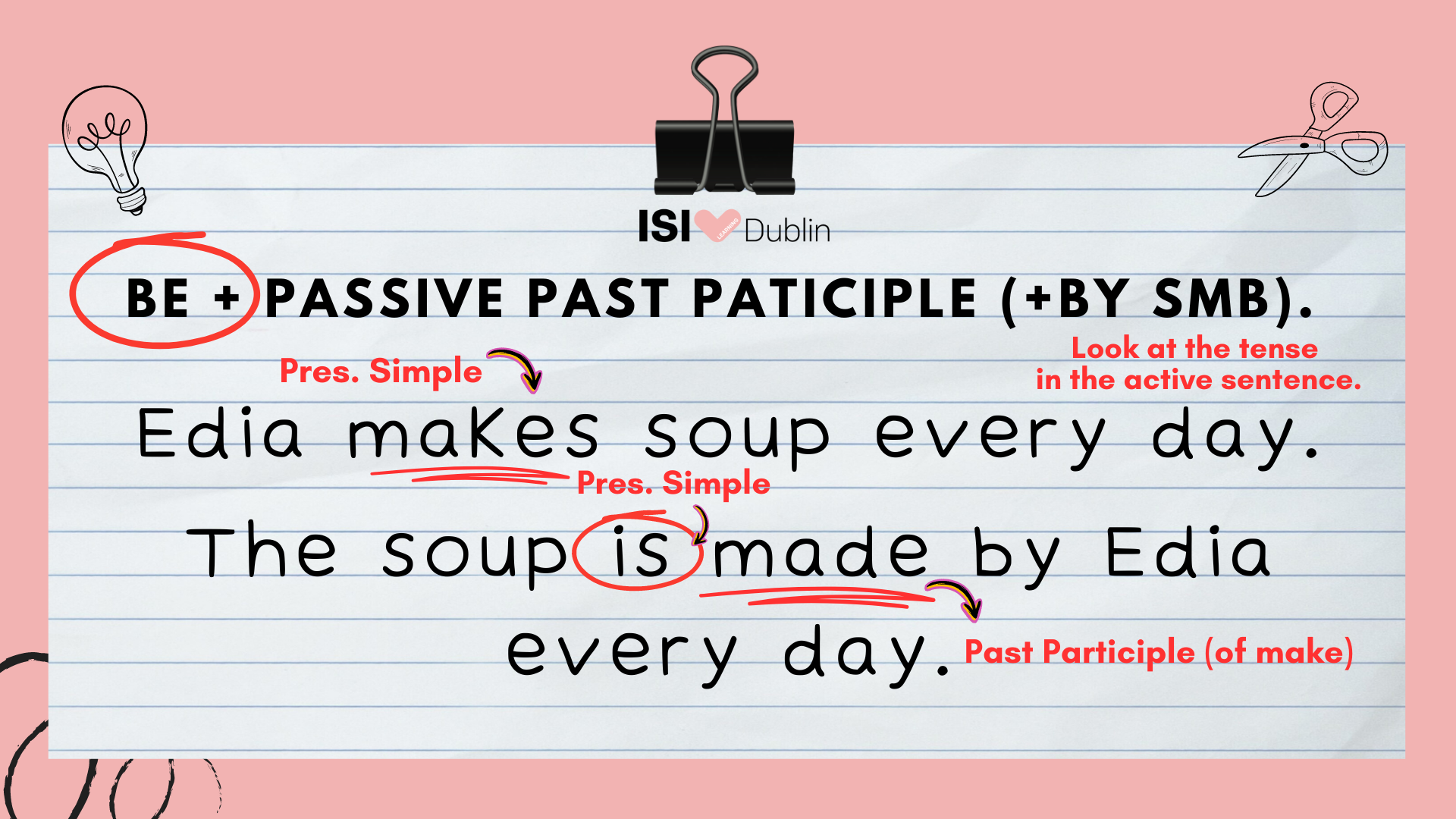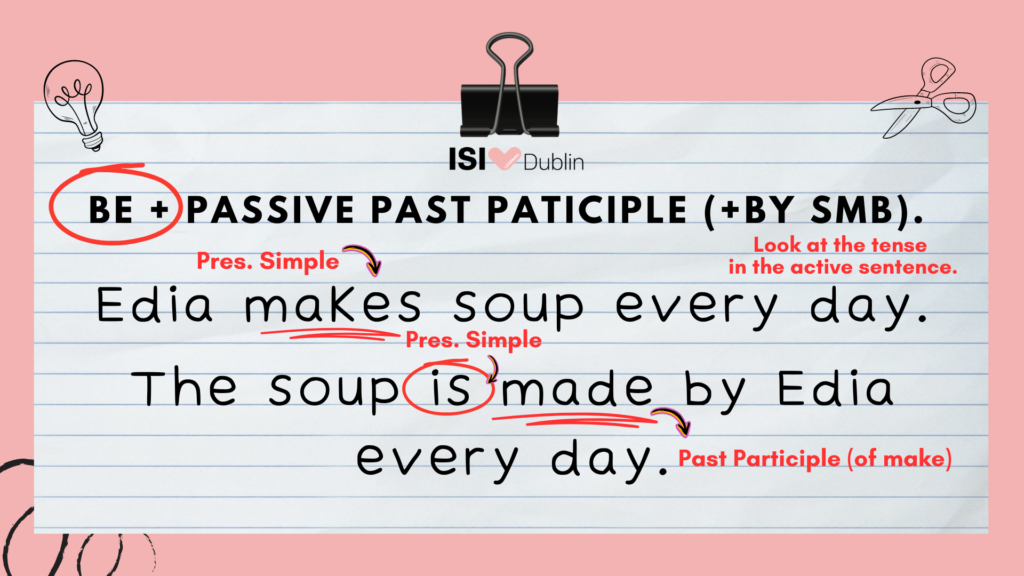Did you know that in the English language we have 12 tenses? Did you know that, in addition, all of these can be made “passive”? In knowing this, you (now) know that you have essentially 24 tenses to master on your English language journey to “Proficiency,” even if we, as native speakers, don’t use all of these on a daily basis in reality! However, my colleague, Rosie, originally from Serbia, has shared a wonderful academic tip with me to help you master the “passive voice” from A1 to C2 level. She learned this tip at Elementary school in Serbia herself, so, it is not only super smart but super suitable for all levels — from beginners to advanced students. Isn’t that wonderful!? Indeed it is, . . . So, come along and read on!

Normal English “Word Order,” as you’ll know from my previous post, is:
SUBJECT + VERB + OBJECT; + PLACE + TIME
I (SUBJECT) teach (VERB) English (OBJECT) at ISI (PLACE) on Tuesdays (TIME).
English is almost always comprised of this Word Order, which we call the “Active Voice,” where there is an Active Agent, i.e., a SUBJECT, causing (and this is the VERB part) the OBJECT or Action):
I (SUBJECT) DO (VERB) MY HOMEWORK (OBJECT).
However, even at Elementary level, we need the “Passive Voice” because the SUBJECT (or Agent, if you like) doing / causing (VERB) the action (OBJECT) is often not known or not important. We come across this a lot in newspapers or news reports for instance. Let’s take the following example — a normal, or “Active,” Subject + Verb + Object; Place + Time, sentence in an English-language newspaper would read:
A MAN (SUBJECT) BROKE (VERB) A WINDOW (OBJECT) IN DUBLIN (PLACE) LAST NIGHT (TIME).
But perhaps it wasn’t a man, perhaps it was a woman? If the newspaper does not know for certain, well, they don’t want to be sued for misinformation, so, they will use the “Passive Voice”!
In this case, they will remove the SUBJECT and the OBJECT will take the place of the SUBJECT in the sentence, and become a PASSIVE SUBJECT, meaning that everything in the sentence that follows happens to it — it did not actively choose to do, or, if you like, choose what follows in the sentence to happen to it.
In the case of the example above, we will get rid of “A MAN (SUBJECT),” replace it with the “(OBJECT) A WINDOW,” which then becomes our PASSIVE SUBJECT.
We now have English Word Order that looks like this —
OBJECT + VERB; + PLACE + TIME
— as opposed to this:
SUBJECT + VERB + OBJECT; + PLACE + TIME
But here’s the tricky bit, which I personally think Rosie makes easy with her academic tip: having moved the OBJECT into the place of the SUBJECT, what do we do with the verb?
Well, the first thing you need to know is that the “Passive Voice” is formed by using some form of the auxiliary verb “BE” + the “PAST PARTICIPLE” of a MAIN VERB: such as SEE, SAW, SEEN, SEEING, or EAT, ATE, EATEN, EATING, or, as in the example above, BREAK, BROKE, BROKEN, BREAKING.
Then, according to Rosie’s super-simple formula, we just have to precede this MAIN VERB with the auxiliary verb “BE” in the exact same tense that the MAIN VERB in the Active sentence reads:
A MAN (SUBJECT) BROKE (VERB) A WINDOW (OBJECT); + PLACE + TIME
BROKE (VERB TENSE: PAST SIMPLE)
(IS, WAS, BEEN)
Now we are ready to make our “Passive Voice” sentence, . . . almost:
A WINDOW (OBJECT/PASSIVE SUBJECT ) WAS BROKEN (VERB); + PLACE + TIME
We can apply this simple logic to all 12 tenses, just remember that no matter how long the verb phrase gets (2,3,4, or even 5 parts) the form of the auxiliary “be” will always be inserted directly before the past participle in each case, i.e. it will always be the second last part of the passive verb phrase!
Let’s try Present Perfect:
A MAN (SUBJECT) HAS BROKEN (VERB) A WINDOW (OBJECT)
BROKEN (VERB TENSE: PRESENT PERFECT)
(IS, WAS, BEEN, BEING)
A WINDOW (OBJECT/PASSIVE SUBJECT ) HAS BEEN BROKEN (VERB); + PLACE + TIME
Let’s try Past Perfect:
A MAN (SUBJECT) HAD BROKEN (VERB) A WINDOW (OBJECT)
BROKEN (VERB TENSE: PAST PERFECT)
(IS, WAS, BEEN, BEING)
A WINDOW (OBJECT/PASSIVE SUBJECT ) HAD BEEN BROKEN (VERB); + PLACE + TIME
Let’s try Future Perfect:
A MAN (SUBJECT) WILL HAVE BROKEN (VERB) A WINDOW (OBJECT)
BROKEN (VERB TENSE: FUTURE PERFECT)
(IS, WAS, BEEN, BEING)
A WINDOW (OBJECT/PASSIVE SUBJECT ) WILL HAVE BEEN BROKEN (VERB); + PLACE + TIME
Let’s try Present Continuous:
A MAN (SUBJECT) IS BREAKING (VERB) A WINDOW (OBJECT)
IS BREAKING (VERB TENSE: PRESENT CONTINUOUS)
(IS, WAS, BEEN, BEING)
A WINDOW (OBJECT/PASSIVE SUBJECT ) IS BEING BROKEN (VERB); + PLACE + TIME
Let’s try Past Continuous:
A MAN (SUBJECT) WAS BREAKING (VERB) A WINDOW (OBJECT)
WAS BREAKING (VERB TENSE: PAST CONTINUOUS)
(IS, WAS, BEEN, BEING)
A WINDOW (OBJECT/PASSIVE SUBJECT ) WAS BEING BROKEN (VERB); + PLACE + TIME
See, English really is easy! One thing you need to remember is that if you want to reintroduce the SUBJECT or Active Agent of a sentence, you need to do it with the little word “by,” which will precede the SUBJECT and come after OBJECT/PASSIVE SUBJECT + VERB, like so:
OBJECT + VERB “by” + PLACE + TIME
A WINDOW (OBJECT/PASSIVE SUBJECT) WAS BROKEN (VERB) by + PLACE + TIME
A WINDOW (OBJECT/PASSIVE SUBJECT) WAS BROKEN (VERB) by A MAN (ACTIVE SUBJECT) IN DUBLIN (PLACE) LAST NIGHT (TIME)
Well, that’s it: the “Passive Voice.” As mentioned, English is easy! A big thanks to my colleague Rosie for making it even easier for me to teach and for you to master! Good luck on your language learning journey towards Proficiency!

